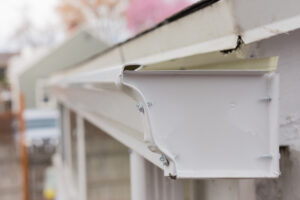Your roof underlayment and ice and water shield play crucial roles in ensuring the stability and longevity of your roof. While they aren’t visible, understanding these essential layers can help you get the most out of your roofing structure.
What is Roof Underlayment?
Roof underlayment is a waterproof or water-resistant material laid on the surface of your roof deck before any other roofing materials are installed. It’s hidden by the shingles and will not be visible when your roof installation is complete.
There are three main types of roofing underlayment, each offering varying degrees of quality and durability.
- Asphalt-Saturated Felt. This underlayment is made of asphalt (bitumen), cellulose (natural plant fibers), and polyester. It is flexible and water-resistant.
- Non-Bitumen Synthetic Underlayment. Made from thermoplastics. It is highly waterproof, durable, flexible, and mold-resistant. It is lightweight and long-lasting.
- Rubberized Asphalt Underlayment. This one is more expensive and provides the most protection. It is made from recycled rubber, asphalt polymers, and even fiberglass for extra reinforcement. This underlayment is waterproof, self-adhesive, flexible, and resistant to UV rays.
The Purpose of Shingle Underlayment
Roofing underlayment adds a layer of protection between your roofing shingles and the structural roof frame. The underlayment keeps your roof deck dry and safe if your shingles are lifted by strong winds. It provides backup protection until the shingles are repaired or replaced.
The underlayment can help prevent the “picture framing” effect, where the pattern or uneven areas of the roof deck show through your shingles. It provides a uniform look for your shingles.
What is an Ice and Water Shield?
Ice and water shield is a self-adhering, waterproof membrane that protects against ice and water damage. The membrane is made of polymer-modified bitumen and goes over your underlayment.
The Purpose of Ice and Water Shield
The peel-and-stick membrane provides a watertight seal at the edge of your roof where ice dams and water infiltration are most prevalent. The bonding agent on the back of these barriers helps protect the roof deck and your home against intense rain and storms. The membrane bonds to the underlayment to form a watertight barrier when properly applied.
The ice and water shield will self-seal around any protrusions, adhering to nails penetrating the underlayment so water or ice cannot penetrate. Covering your roof deck with ice and water shield will make your roof more resistant to the aftereffects of strong winds.
Your roof underlayment and ice and water shield can help prolong the life of your roof and keep your home dry. For expert roofing services in the Southern New Hampshire and Northern Massachusetts areas, Adam Vaillancourt Roofing is ready to help. Contact us today to schedule a free roof inspection to determine if your roof underlayment and ice and water shield are in good working condition.




